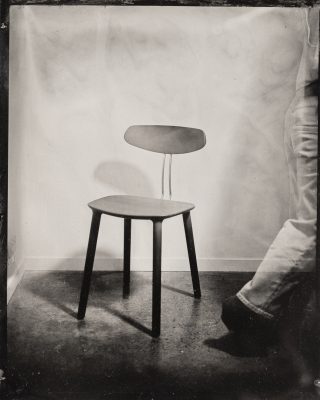In today's world, photography is an ephemeral art form. You can take countless photos and easily edit them to perfection with just a touch. But it wasn't always this way. There was a time when you might only get one photograph of yourself or your family in a lifetime.
The wet plate process (also known as tin-type photography) developed in 1850, is a prime example of this. It was a highly skilled and technical procedure that involved coating a tin plate with silver, exposing it to light, and then processing the plate to produce a unique photograph. Sitters had to remain perfectly still while the photographer worked, creating an image with a timeless, moody quality that feels like stepping back in time.
This process makes us reflect on how quickly we can now alter the history of our lives through editing and filtering images, whereas once, these photographs were all we had to document the present.
 Sold
Sold
In the chair 2024
Tin-type photograph
10 x 12.5 cm
 Sold
Sold
Bonnie 2024
Tin-type photograph
10 x 12.5 cm
 Sold
Sold
Annabelle 2024
Tin-type photograph
10 x 12.5 cm
 Sold
Sold
Melissa And Jenson 2024
Tin-type photograph
10 x 12.5 cm
 Sold
Sold
Melissa 2024
Tin-type Photograph
10 x 12.5 cm
 Sold
Sold
Jenson 2024
Tin-type photograph
10 x 12.5 cm
 Sold
Sold
Emily And Jordan 2024
Tin-type photograph
10 x 12.5 cm
 Sold
Sold
Justine 2024
Tin-type photography
10 x 12.5 cm
 Sold
Sold
Leesa 2024
Tin-type photograph
10 x 12.5 cm
 Sold
Sold
Frances and Alex 2024
Tin-type photograph
10 x 12.5 cm
 Sold
Sold
Claire And Partner 2024
Tin-type photograph
10 x 12.5 cm
 Sold
Sold
Minnie 2024
Tin-type photograph
10 x 12.5 cm
 Sold
Sold
Liz And Minnie 2024
Tin-type photograph
10 x 12.5 cm
 Sold
Sold
Bonnie 2024
Tin-type photograph
10 x 12.5 cm
 Sold
Sold
Luis 2024
Tin-type photograph
10 x 12.5 cm
 Sold
Sold
Annabelle 2024
Tin-type photograph
10 x 12.5 cm
 Sold
Sold
The Wards 2024
Tin-type photograph
10 x 12.5 cm
 Sold
Sold
Laura 2024
Tin-type photograph
10 x 12.5 cm
 Sold
Sold
Phoebe 2024
Tin-type photograph
10 x 12.5 cm
 Sold
Sold
Sadie and Lucy 2024
Tin-type photograph
10 x 12.5 cm
 Sold
Sold
Suze 2024
Tin-type photograph
10 x 12.5 cm
 Sold
Sold
Cindy 2024
Tin-type photograph
10 x 12.5 cm
 Sold
Sold
Alicia 2024
Tin-type photograph
10 x 12.5 cm
 Sold
Sold
Amanda 2024
Tin-type photograph
10 x 12.5 cm
 Sold
Sold
The Jursts 2024
Tin-type photograph
10 x 12.5 cm
 Sold
Sold
Andre And Vanessa 2024
Tin-type photograph
10 x 12.5 cm
 Sold
Sold
The Morgans 2024
Tin-type photograph
10 x 12.5 cm
 Sold
Sold
Marcus Bell 2024
Tin-type photograph
10 x 12.5 cm
 Sold
Sold
Leesa 2024
Tin-type photograph
10 x 12.5 cm
 Sold
Sold
Laura 2024
Tin-type photograph
10 x 12.5 cm
 Sold
Sold
Leesa And Laura 2024
Tin-type photograph
10 x 12.5 cm

In The Chair 2024
Tin-type photograph
10 x 12.5 cm
POA

